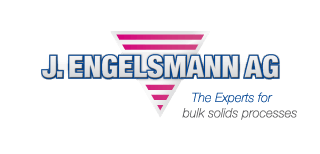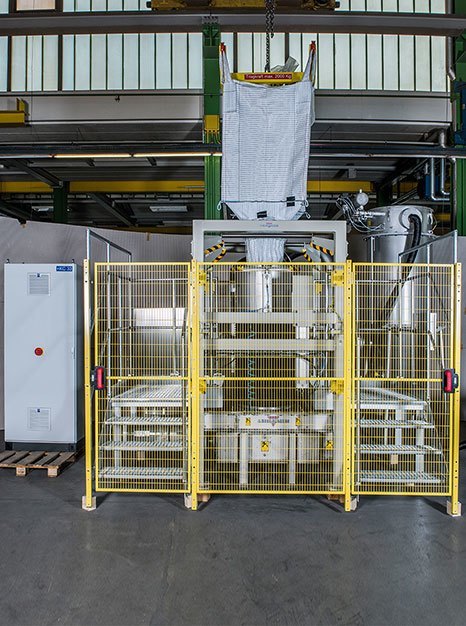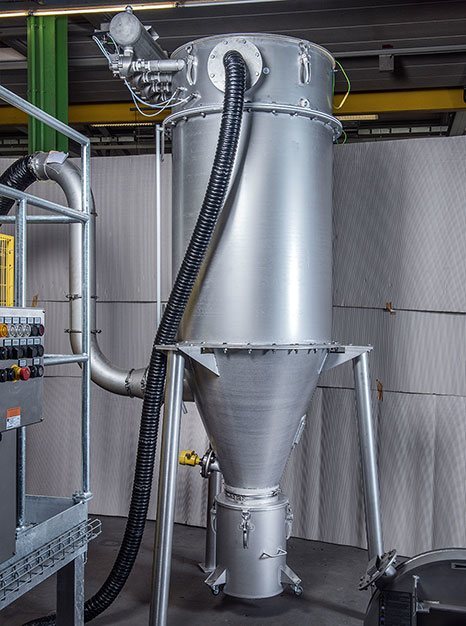05.10.2015
More Capacity through Automated Big Bag Handling
When it comes to filling and emptying big bags, the highest standards of safety and product handling are to be fulfilled. Dust-laden and adhesive bulk goods in particular require reliable and intelligent system solutions that are not only adapted to the production-specific conditions but also ensure high capacity, as demonstrated by a current project from the chemical industry of bulk goods specialist J. Engelsmann AG.
A leading chemicals producer was searching for a fully automated system for filling and emptying big bags to integrate it into its plant protection production site. The desired turnkey solution was to ensure a significant increase of the previous production capacity and also enable lower personnel deployment.
Tightness and productivity - the highest priority in system execution
The complete production facility extends across four levels. The big bag emptying and filling system, which is based on two different process chains, was to be integrated at the beginning and the end of the production process. In the design and production of the system solution, consisting of two units, the complete manufacturing and process engineering had to be tailored to the existing conditions. A particular challenge was to adapt the system units to the spatial conditions on site. Since the emptying and filling processes had to be integrated into an existing system, each installation site was specified and the limited space was to be taken into account in detail in the system design. Furthermore, control of the emptying and filling system had to be compatible with the existing process control system and communicate with it faultlessly. The product to be manufactured also placed high requirements on the execution of the systems and their processes. The fragile product, which tends to clump, is dust-laden and strongly adhesive, which, in addition to high tightness of the system components, also required a corresponding surface condition of the materials used. The products are fed in big bags. These are brought into the emptying system using a docking mechanism, which is stronger in design due to the high tightness. The emptying system is equipped with a pneumatically activated emptying unit and a tightening device. To ensure a residue-free emptying of the big bags without dust development, they are evacuated in fully automated fashion after the emptying process. The big bag cargo gear has an inliner clip and an additional hook for smaller bags. Using an installed double-shaft crusher, the clumped product is broken or split after the emptying process and is fed into a dryer on the site. After the drying process, the product reaches the filling system, where an inflation device fills the big bags with air prior to the filling process in order to erect the big bag fully and thus achieve an optimal filling quantity.
Trickle protection system for contamination-free big bag filling
Owing to the dust-laden product, the emptying and filling systems are designed as dustproof for the protection of the operating staff and they are equipped with a suction device for aspiration. An installed trickle protection system (JEL FlowStop) prevents possible product contamination of the system environment. In the process, the inlet connection of the big bag to be filled is held and attached by means of an integrated inflation sleeve. The stainless steel trickle protection consists of a two-part protective cap, which closes during or after the filling process. The product is thus prevented from trickling out of the feed pipe and the operating staff as well as downstream system components are protected from possible product contamination. Lubricated parts are not used in the interior, thus preventing the product from being soiled. In addition, the low proportion of wear parts used ensures low-maintenance operation.
To ensure maximum capacity utilization and fast cleaning of the system units, all components that come into contact with the product are made of stainless steel. The smooth surfaces of the funnels and intersections are designed as steep as possible (angle against the vertical line <20°) in order to prevent adhesion of the product as far as possible. Set up in the production area, both system units are also designed with explosion protection. In addition to planning, design and production of the systems, the project scope also included installation, commissioning and training the operating staff.








